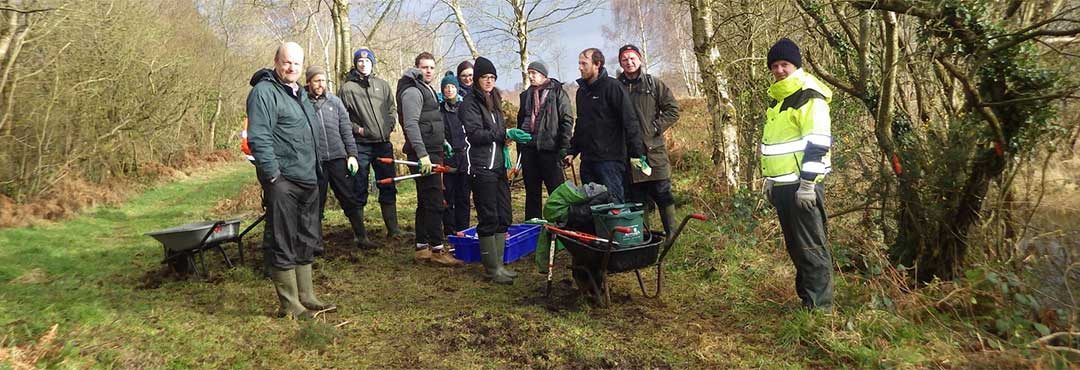In general the purple moor grassland and rush pastures are grasslands with varying proportions of grasses, sedges, rushes together with a mixture of herbs characteristic of grasslands, wetlands and heathlands. A more detailed description of the purple moor grassland and rush pastures are defined as being grasslands which:
- are dominated by purple moor grass Molina caerulea and/or tall rush predominately Sharp flowered rush, Juncus acutiflorus. Purple moor grass is a tufted, upright grass with green foliage and a distinctive purple tinged, flowering spike giving it its name. The flowers are usually seen from July to September and can reach an average height of between 18 and 24 inches. The sharp-flowered rush is a tall, jointed rush producing flowers from July to September. The flowers are small, star shaped and reddish brown in colour. The rush can grow up to 120 cms in height.
- include a suite of characteristic plant species which can include devil’s-bit scabious, meadow thistle Cirsium dissectum and tormentil Potentilla erecta. These are mostly found in the sites dominated by purple moor grass, however on a site that is dominated by rush, you will find other plants such as marsh bedstraw Galium palustre and wild angelica Angelica sylvestris.
- will have less than 25% cover of scrub or dwarf shrub.
Purple moor grass and rush pastures often occur in complex mosaics with other communities and habitats such as wet heaths, dry grassland, swamp, scrub and flushes and consequently transitions are often very common. Purple moor-grass and rush pastures frequently grade into marsh and there are many similarities in the range of species present in both.
Historical info about Purple moor grassland and rush pasture
Northern Ireland holds responsibility for a large portion of the European resource and is also thought to contain about a third (18,700 ha) of the estimated UK total. This is approximately 1.2% of the total land area with slightly over half this amount occurring within the Fermanagh District. Elsewhere, however, the resource is widely scattered.
In Northern Ireland, the best estimate of the area of purple moor-grass and rush pasture is based on the Northern Ireland Countryside Survey (NICS) which conducted investigations into extensive areas of Northern Ireland between 1987 and 1992. The NICS provides the baseline for an assessment of habitat change over time and originally estimated a total of around 26,000 ha, when the assessment was repeated in 2000 (NICS 2000) and showed a rapid decline in fen meadow and species rich wet grassland between 1991 and 1998.
The comparable figure from NICS 2000 is an estimate of 18,919 ha. This equates to an overall net loss of about a third of the Northern Ireland purple moor-grass and rush pastures resource between of 1991 and 1998.
Species living in and around Purple moor grassland and rush pasture
The purple moor and rush pastures play an important role in providing areas where different priority species can live, feed and breed; this includes birds such as the skylark, curlew and the reed bunting.
Other animals found here are the marsh fritillary butterfly, Irish hare and the ground beetle.
It also provides an area for other UK priority species of plantlife to grow such as the blue-eyed grass Sysyrinchium bermudiana and the Irish lady’s-tresses orchid.
Threats to Purple moor grassland and rush pasture
The survival of these areas depends on conditions such wet or water logged soils, low nutrient levels and low levels of intermediate disturbance, i.e. grazing or cropping. There are many factors that can affect the success of these conditions, these include:
Agricultural improvements like cultivation, drainage, fertiliser and pesticides application, ploughing and re-seeding and the most significant of all threats to these areas.
It is important for the purple moor grassland and rush pastures to be managed by low level cutting, grazing or burning as in small-scale periodic winter burning to maintain the quality of a site. Abandonment of an areas results in a change in vegetation leading to rankness and the development of scrub, woodland, and in some cases, heath. However too much of these methods of control can also be damaging. Over grazing results in a reduction in species diversity, whereas over-burning or burning of areas in too large a scale will result in complete loss of habitat structure.
Afforestation, particularly dominated by commercial coniferous plantations has resulted in a significant loss of this habitat.
As the purple moor grassland and rush pastures are associated with wet corners and depressions the infilling of fields will result in a loss of habitat. Infilling is carried out to create level-filled fields or increase the area for suitable cultivation.
Habitat fragmentation, planning developments, airborne pollution and climate change could all have a negative effect on the areas of purple moor grassland and rush pastures and could contribute towards their decline.

